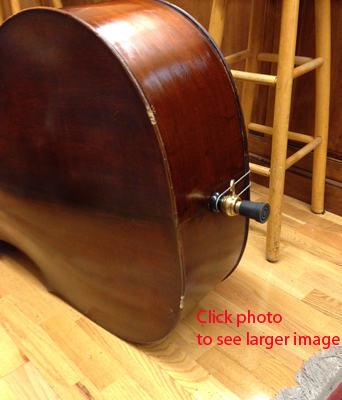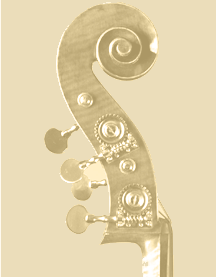 |
 |
Home |
 |
 |
Bass Café |
 |
 |
Giovani Battista Rogeri Basses
(Italian model, $4950) |
 |
 |
Wan-Bernadel Deluxe Basses
(French model, $4950) |
 |
 |
Basses Under $3,000: Thompson Plywoods, Hybrids, Emile
Gillet, starting at $1,485 |
 |
 |
Bass Bows |
 |
 |
Upright Bass Strings |
 |
 |
Bass Sheet Music, Methods
& Etude Books |
 |
 |
Bass CD / DVDs |
 |
 |
Bass Accessories (Rosin, Pickups, Metronomes, Tuners, Amps
etc...) |
 |
 |
Bass Covers & Bow Cases |
 |
 |
Bass Flight Cases |
 |
 |
Bass Teacher Directory |
 |
 |
Cellos |
 |
 |
Violin, Viola & Cello Cases |
 |
 |
Gift Certificates |
 |
 |
About
Us |
 |
 |
Contact Us |
 |
|
|
|
| |
|
Don't Buy Bass Covers with Wheels Built in
Them!There is good reason that we have never (nor will we ever)
offer a bass cover here with wheels installed at the bottom of the cover. It seems fairly innocuous at
first...just a good idea and an easier way to handle and transport a
bass. Right? This was surely designed by someone that doesn't
completely understand the value of an upright bass, respect it as
they should or just simply doesn't understand what these covers will
do to a bass over time. Quite simply, they break the bass!
at the bottom of the cover. It seems fairly innocuous at
first...just a good idea and an easier way to handle and transport a
bass. Right? This was surely designed by someone that doesn't
completely understand the value of an upright bass, respect it as
they should or just simply doesn't understand what these covers will
do to a bass over time. Quite simply, they break the bass!
No matter how 'safe' the manufacturer or dealer that sells these
bass case/cover claims and no matter how much padding they are
supposed to have, don't buy one! The wheels which
are attached permanently at each side of the bottom edge of the
bass, allows the player to simple push their bass down the sidewalk
or pavement. While it seemed like a great time saver and
convenience, the wheels give
direct impact to the beloved
instrument on each crack or bump they roll over or into. A hole or
rut in the pavement? BAM! You got it, right into the bass. With
these bass cover (trolleys built in) there is really no way they can
dependably protect from hitting the bass. Our famous
Tuff-Bag bass covers, will never have wheels.
Here's a bass that we just got in. A nice bass! Over time
though, the player used this cover not quite realizing what directly
hitting the bottom edge will do to it over time ('a couple 2 or 3
years of easy use' he said.) The bottom of this bass has two very
broken edges which will now require us to graft two new edges (each
about 1 1/2" wide on each side.) This takes a lot of time,
expertise and patience to make the repair look seamless. We will
try to repair this so that it will look like it never happened, by
matching the wood grain, matching the varnish (easier said then
done!) and in some places even having to inlay the missing
purfling. In addition to the broken edges shown here, the bass has
huge scar indentations where the wheel pressed (through the cover)
and then put deep indentations into the maple wood, just above each
area where the edges were broken. Additionally, due to the same
cover design, the bass sustained too many impact shots which
dislodged the endpin block and seam, even jarrying the rib seam at
the very bottom of the bass to erode all the glue allowing the ribs
to begin peeling away from the bass. And this is a good, well made
('keeper') bass. All can be fixed, but for a price...and needlessly
so!
It's simple. Don't buy a cover that will do this sort of
thing to your bass, no matter what they say or how padded they say
that 'their' special cover is. Obviously, the safeest, cleanest way
to get your bass from point A to point B is to get a good cover and
carry it. While this is the perfect way for your bass, it is not
the most practical to have to carry a heavy bass with accessories
attached! We endorse using a low impact bass wheel that simply goes
into the same hole (and size) as the endpin shaft. Take the endpin
out (most covers have an endpin pocket in the back of the cover),
and then put the wheel in. Our
String Emporium Bass Wheel
does not require air, but the hard wearing foam wheel absorbs
the most shock of any wheel and will not need to be replaced or go
flat. We like wheels that are separate from the cover and far away
from the body of the bass. When using even a good bass wheel, use
common sense: Don't push and bump your bass going down the stairs!
(No da!!! But you would be amazed by what people will do.) When
strolling with your bass, outside perhaps, always look ahead to be
aware of any potential hard bumps: If you see a questionable ridge
or bumple coming up, then simply lift the bass over that to the next
level. While not as perfect as carrying a bass, the separate
removable wheel is seated right into the most solid of all areas:
The endpin block. Basses that have sustained endpin block damage,
is usually caused by some very hard, violent impact onto the endpin.
Not from wheeling it.
While it looked like such a great idea
at first, the covers with bottom wheels mounted or built into the
bottom of the bass cover are bad idea and will almost surely damage
a bass over time. Even the small little sidewalk bumps (clicks)
when you are walking will eventually wear down the edges and break
them off.
|
|


